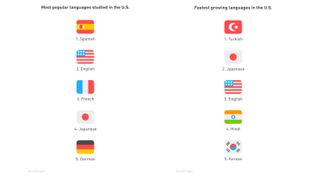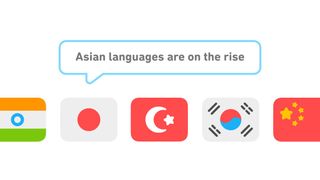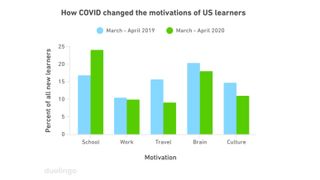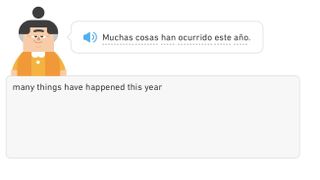The Covid-19 pandemic has boosted language learning by over 50%, and according to a new report from Duolingo, it’s also changed people’s main motivation for learning. In its 2020 report, Duolingo revealed that while English remains the most popular language to learn in 62% of countries, “In the US, Spanish comes out on top as the most studied language in all 50 states and Washington, D.C., though English is the top language studied among Duolingo learners in Puerto Rico.”
Commenting on the results, Duolingo's Senior Learning Scientist, Dr. Cindy Blanco, said "during lockdown, learners around the globe looked for ways to feel connected, and so millions of people began learning a new language. Duolingo's data reveals where and when people began learning their community’s own language, studying to keep up with schoolwork, and trying out the languages behind some of our other favorite quarantine activities, like binging on Netflix and streaming music from around the world."
The five most popular languages to learn in the US, as well as the fastest growing languages, are as follows:

Duolingo notes that the US stands apart from other English-speaking countries worldwide because the language is one of the most popular choices among learners. This is down the immigrant population in the US, who are learning English “in order to better acclimate and fulfill both personal and professional goals.” Duolingo is our top pick of the best learn English software for kids especially, but it offers 38 languages in total.
Worldwide, Spanish has officially overtaken French as the second most learned language on Duolingo. No matter which of the two languages you’re learning, Duolingo features in our guides to the best learn Spanish online software and the best learn French software and apps alike.
Duolingo also highlights the role that popular culture has on language learning, noting that all five of the fastest-growing languages around the world are Asian languages. This shows that the global popularity of Asian culture is not a phase, with KPOP, BTS and Academy Award best picture winner Parasite all credited with the rise.

According to Duolingo, "Learners' motivations indicate that school is the most important factor in studying these Asian languages, followed by brain training.
Travel and culture have been important motivators for Korean and Japanese learners - further evidence of the pull of K-pop and the entertainment industry on language-learning patterns. On the other hand, students of Hindi are more likely to report studying the language for family reasons."
Duolingo reports less travel-related learning in 2020

If you were learning a new language to complement your travels, 2020 was not the year for you. While the coronavirus pandemic grounded many people’s travel plans, this didn’t stop new learners from taking up a language.
“Most notably this spring, we have seen a 7% increase in people in the US learning for school purposes compared to spring 2019,” said Duolingo. “This makes sense, given that most schools in the US transitioned to virtual learning starting in March, and in this new environment, teachers and students have been using Duolingo even more than before as a supplement to their foreign language curricula.”
How does the US compare?
The 51% rise in new Duolingo users is evidence of Americans' good intentions, but much like that sourdough starter, or the online piano lessons you started, it can be hard to find the dedication required to pick up a new skill. "The United States ranks 68th on Duolingo’s list of Hardest Ranking language learners globally", with Germany taking the top spot.
That's not all though. Duolingo has been keeping track of the most (and least) dedicated states across the US, so how does yours rank?
For more fun new hobbies, try our guides to the best typing software and the best comic creator software.

